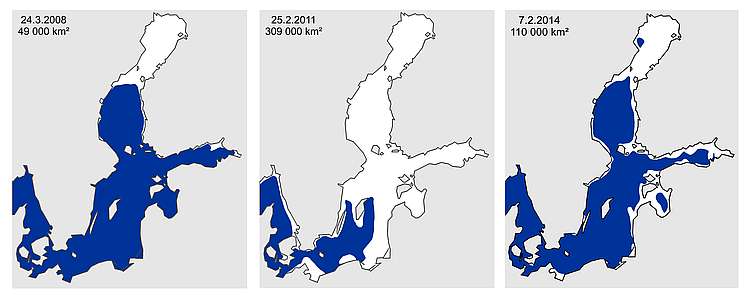Ice season in the Baltic Sea
In the Baltic Sea ice conditions vary greatly. The annual ice cover is at its greatest between January and March, usually around the end of February/beginning of March.
On average, ice covers an area of some 170 000 km², which stands for 40 % of the total Baltic Sea area (422 000 km², including Kattegatt and Skagerrak). The minimum ice extent has been on winter 2020 when there was only 37 000 km² ice in maximum.
The ice formation in the Baltic Sea starts along the coasts of the northern Bay of Bothnia and the inner Gulf of Finland. This occurs usually in October–November. Thereafter the freezing spreads to the Quark, the open Bay of Bothnia and the coasts of Sea of Bothnia. In normal winters the ice gets to cover also the rest of the Sea of Bothnia, the Archipelago Sea, the whole Gulf of Finland and parts of the northern Baltic Proper.
In mild winters the Sea of Bothnia doesn't freeze at all and the Gulf of Finland only gets a partial ice cover. In severe winters the ice reaches the Danish Sounds and the central Baltic Proper. The last area that freezes up is an area north-east of Bornholm in the Southern Baltic Sea.
The melting season starts in April and proceeds from the south to the north. In the northern Baltic Proper the ice disappears in early April. By the beginning of May there is only ice left in the northern Bay of Bothnia, where also the last ice pieces melt away by the beginning of June.
Ice seasons severity
The Finnish Ice Service of the FMI classifies the severity of the Baltic Sea ice seasons into three classes: mild, average and severe. Fourth class, extremely severe can also be used. Classification is done according to maximum extent of ice cover and it is based on winters 1960/1961–2009/2010.
The maximum ice extent has been calculated for the day when the annual maximum has been reached. In calculations ice concentration, thickness or ice deformation degree have not been taken in account. The classification is based on the area of the total ice extent.

It should be noticed, that mild ice season could not be easy in perspective of ice navigation, and on the other hand, severe seasons might not be difficult. Average seasons are the hardest for ice navigation. The warm and windy periods between cold periods cause ice drift followed by ice pressure and ridging in the ice fields. Cold and calm periods increase amount of ice, which will with next windy period drift against the close drift ice edges, and brash ice barriers are formed, which makes the ice field difficult to force.
